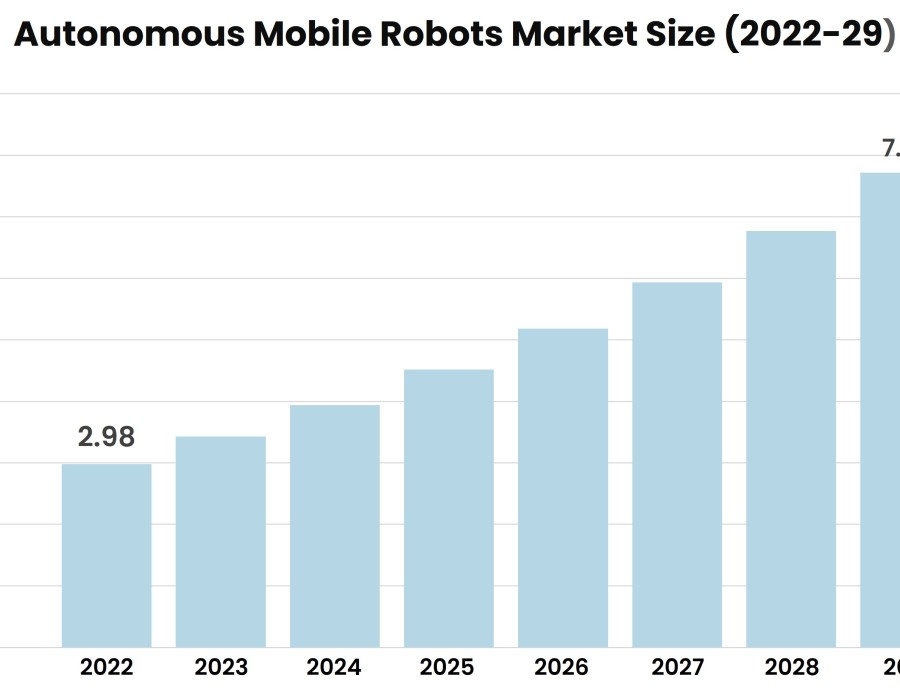The autonomous mobile robots market is experiencing a transformative phase, driven by advancements in technology and the growing demand for automation across various industries. These robots, designed to perform tasks without human intervention, are becoming integral to sectors such as manufacturing, logistics, healthcare, and retail. As businesses strive for efficiency, accuracy, and cost-effectiveness, the adoption of AMRs is accelerating, ushering in a new era of innovation and productivity.
According to Stratview Research, the autonomous mobile robots market was estimated at USD 2.98 billion in 2022 and is likely to grow at a CAGR of 14.42% during 2023-2029 to reach USD 7.72 billion in 2029.
1. Technological Advancements and AI Integration
One of the primary trends driving the autonomous mobile robots market is the integration of artificial intelligence (AI) and machine learning (ML). These technologies enhance the robots' ability to navigate complex environments, make real-time decisions, and improve operational efficiency. AI-powered AMRs can adapt to changing conditions, optimize routes, and perform tasks with minimal human intervention. The continuous improvement in AI algorithms and sensor technologies, such as LiDAR and 3D cameras, is expanding the capabilities of autonomous mobile robots, making them more versatile and reliable.
2. Growing Demand in E-commerce and Logistics
The e-commerce boom, fueled by changing consumer behaviors and the demand for faster delivery times, is significantly impacting the autonomous mobile robots market. Warehouses and distribution centers are increasingly deploying AMRs to streamline operations, manage inventory, and enhance order fulfillment processes. These robots can efficiently handle tasks such as picking, packing, and transporting goods, reducing the reliance on manual labor and minimizing errors. The scalability and flexibility of AMRs make them ideal for addressing the dynamic needs of the e-commerce sector.
3. Enhanced Collaboration and Human-Robot Interaction
Collaboration between humans and robots is another emerging trend in the autonomous mobile robots market. Cobots, or collaborative robots, are designed to work alongside human workers, enhancing productivity and safety. These robots can assist with repetitive or physically demanding tasks, allowing human workers to focus on more complex and value-added activities. Improved human-robot interaction (HRI) interfaces and safety features ensure seamless and safe collaboration, fostering a more efficient and harmonious work environment.
4. Expansion into New Industries
While manufacturing and logistics have been the primary adopters of autonomous mobile robots, other industries are also recognizing their potential. In healthcare, AMRs are used for tasks such as transporting medical supplies, sterilizing environments, and assisting in surgeries. Retailers are deploying A autonomous mobile robots MRs for inventory management and customer service. The agricultural sector is exploring the use of autonomous mobile robots for precision farming, planting, and harvesting. This diversification is driving market growth and expanding the applications of autonomous mobile robots.
5. Sustainability and Energy Efficiency
Sustainability is becoming a key focus in the autonomous mobile robots market. Manufacturers are developing energy-efficient robots with longer battery life and faster charging capabilities. Additionally, autonomous mobile robots contribute to reducing the carbon footprint by optimizing resource utilization and minimizing waste. The emphasis on sustainability is aligning the autonomous mobile robots market with broader environmental goals and regulations, making these robots an attractive option for eco-conscious businesses.
In conclusion, the autonomous mobile robots market is poised for significant growth, driven by technological advancements, increasing demand in e-commerce, enhanced human-robot collaboration, expansion into new industries, and a focus on sustainability. As these trends continue to evolve, autonomous mobile robots will play a crucial role in shaping the future of automation and driving operational excellence across various sectors.






Comments